Scott – Owner and former helmet buyer for the bicycle industry – offers his advice
Helmets have become the norm over recent years on the mountain and for good reason – They not only offer increased protection in the event of a collision or fall, but they also offer the benefit of warmth from the elements on colder days on the mountain.
When I choose our range of helmets, its based not on price or colour, but on the various types of head shapes we have visit us at The Skiers Lounge, and features that help customers. For example, someone who always gets hot on the mountain will want maximum ventilation, someone who gets cold will need to be able to shut ventilation off.
How do I get the right size helmet?
You can determine your helmet size by measuring the circumference of your head in cm. Measure around the largest part of your head keeping the tape level to get your head circumference. Then look at the sizing information for the helmet you are looking at, to determine which size option is best for you.

When you have done this and chosen your helmet, when you put it on it should be snug not tight – there is usually a micro adjustment system on most helmets to fine tune the fit. Roll your head side to side and the helmet should not move. If it does adjust the fit or try another size.
Head Shapes – What is an oval head shape vs a round head shape?
All head shapes are slightly different. Therefore, ski brands make helmets make shell shapes that are different too. While no head shape is ever truly round, a rounder helmet profile will suit those who feel they have a round head.

For those with a more round head shape, when they put on an oval profile helmet, they will often feel a tell-tale pinching in the temples either side of their head when the helmet is adjusted, at the 2 o’clock and 10 o’clock position. If you are getting that feeling in your rental or current helmet, then the likelihood is you need a slightly more round shape design. For those with a more oval shape head, you will feel more pressure at the 12 o’clock and 6 o’clock position if you are trying a round helmet shape.
Even within brands there is some variety in shapes so ready our product information carefully and if you are unable to visit our new helmet showroom coming this winter, then contact us if you need more information to help you buy correctly online.
How should my goggles fit with my helmet?
Most modern ski and snowboard helmets work with most modern goggle designs. Brands do optimise their designs to match their goggle designs, but this does not mean you cannot mix and match – and indeed here at The Skiers Lounge all of us do, but do check the fit. There should be no gap between the top of your goggles and the helmet, as we want the foam at the top to stay dry and not be exposed to the elements, but you also don’t want the helmet pressing the goggles down onto your nose.

What are the differences in helmet construction?
Helmets generally come in 2 construction types or a blend of the 2. In-moulded helmets attach directly to the shock absorbing foam core of the helmet, offering lighter weight and a lower profile. This process can be more expensive to produce.
Injection-moulded helmets have a harder outer shell made of high impact plastics. This makes these helmets more durable for everyday use or clumsy users than an in-moulded helmet, but they are a little heavier as a result.
How should I store my ski helmet?
We recommend keeping your ski and snowboard helmet out of direct sunlight and avoid humid areas of your home such as the loft. The plastics can react to heat and temperature changes, so our favourite places here are under the bed, or in the back of a wardrobe out of harms way.
5 features on ski and snowboard helmets we really like…
Mips or Multi-Directional Impact Protection System – This clever safety feature is proven (Ask to see my post-crash helmet in our showroom!) as it adds a low friction layer between your head and the outer shell. On impact it reduces rotational impact forces on your skull, helping to protect the brain from concussion and trauma. This is why most of the helmets we sell feature Mips as we think the slight increase in cost is worth the investment.
Adjustable Ventilation – Being able to shut down and open ventilation can make a big difference to comfort on the mountains and the ski lifts too. Many have external slide switches and others will require you to remove your helmet and block the vents with liner flaps. The external switch versions are therefore better for conditions where it can get changeable and very cold at times.
Dial Fit Adjustment and Height Adjustment – Some of the models we stock feature an adjustable dial for easy tweaking of the fit, which can also be used to allow you to wear a thin hat underneath when very cold. Additionally, height adjustable fitting allows you to fine tune the fit at the base of your skull to improve the fit even further.
Google Ventilation Ports or “Stack Vents” – These help air to flow over the top of your ski googles, which helps to prevent fogging up. To keep goggles fog free the foam on the top needs to be dry and well ventilated and little vent ports will help with this.
Removable Liner – A removable liner is great as it allows you to easily remove the liner and give it a wash after a sweaty trip to the mountain.




